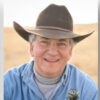Earth Day: Enjoy a Glimpse; Appreciate the Big Picture

On Saturday, I was fortunate to capture some video clips of a bison mom helping her newborn calf learn to cross a deep ravine as I was helping move the animals to a new pasture at the ranch where we keep our herd. I posted the clips on Facebook, mentioning how privileged I was to glimpse this small sliver in the circle of life, and was overwhelmed by the warm response that post received.
Bison ranchers are indeed privileged to see this sliver of the circle of life each spring.
Producers across North America are enjoying similar scenes as newborn red calves test their wobbly legs in pastures turning green with fresh grass. As we smile at that sliver, Earth Day is a time for us to think about the entire circle.
That baby calf was able to cross a ravine within an hour of birth because bison have survived through the ages in a delicate balance with predators. Being able to keep pace with a constantly moving herd was vital for survival.
Bison calves arrive just as the grass is greening because bison evolved in concert with the grassland ecosystems over thousands of years. Fresh grass provides the high quality nutrition that mom needs as she nurses her newborn. And, she will start to regain the weight she lost through the winter, which will help her to be in optimal condition for the breeding season in a few months.
Bison mom and calf definitely benefit from a healthy earth.
The earth, too, benefits from the bison. Managed properly, bison grazing stimulates new plant growth. Manure and urine provide the soil with vital nutrients, hoof action stirs soil and buries seeds. Wallowing creates depressions that will capture precious rainfall in a climate where moisture is scattered and infrequent.
These healthy grasslands capture carbon from the atmosphere and return it to the soil. The grasslands, in a sense, are the rainforests of North America’s semi-arid regions. Meanwhile, this ecosystem provides habitat for an abundance of wildlife.
Predators are an important part of that circle as well. The grasses and plants in these ecosystems evolved as bison and other grazers moved across the landscape in tightly-bunched herds as a defense against the predators. The predators kept the bison population in check, preserving the balance between animals and the land.
Humans have always been the keystone predator. After all, bison transform the cellulose of the grasses and other plants into a nutrient-dense, delicious protein. A couple years from now, many of these new calves will be headed to market, and ultimately to our dinnerplates. That’s kind of tough to think about as we see new calves hit the ground, but the market for bison meat provides the economic sustainability that is helping ranchers restore bison to native habitat across North America.
Earth Day is a time for us to think about—and appreciate—the entire circle of life…even when we glimpse only a sliver.
